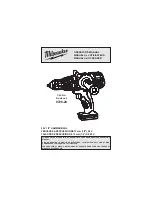
6
English
OPERATION
Hold the drill firmly and place the bit at the point to be
drilled.
Depress the trigger switch to start the drill.
Move the drill bit into the workpiece, applying only
enough pressure to keep the bit cutting. Do not force
the drill or apply side pressure to elongate a hole. Let
the tool do the work.
WARNING
:
Be prepared for binding at bit breakthrough.
When these situations occur, drill has a tendency
to grab and kick opposite to the direction of
rotation and could cause loss of control when
breaking through material. If not prepared, this
loss of control can result in possible serious
injury.
When drilling hard, smooth surfaces, use a center
punch to mark the desired hole location. This will
prevent the drill bit from slipping off-center as the hole
is started.
When drilling metals, use a light oil on the drill bit to
keep it from overheating. The oil will prolong the life
of the bit and increase the drilling action.
If the bit jams in the workpiece or if the drill stalls,
stop the tool immediately. Remove the bit from the
workpiece and determine the reason for jamming.
NOTE:
This drill has an electric brake. When the trigger
switch is released, the chuck stops turning. When the
brake is functioning properly, sparks will be visible
through the vent slots on the housing. This is normal and
is the action of the brake.
MAINTENANCE
WARNING
When servicing, use only identical RYOBI
replacement parts. Use of any other parts may
create a hazard or cause product damage.
Avoid using solvents when cleaning plastic parts. Most
plastics are susceptible to damage from various types of
commercial solvents and may be damaged by their use.
Use clean cloths to remove dirt, dust, oil, grease, etc.
WARNING
Do not at any time let brake fluids, gasoline,
petroleumbased products, penetrating oils, etc.,
come in contact with plastic parts. Chemicals can
damage, weaken or destroy plastic which may
result in serious personal injury.
Do not abuse power tools. Abusive practices can damage
tool as well as workpiece.
WARNING
Do not attempt to modify this tool or create
accessories not recommended for use with this
tool. Any such alteration or modification is misuse
and could result in a hazardous condition leading
to possible serious personal injury.
Summary of Contents for LCDI1402
Page 1: ...14 4 VOLT COMPACT HAMMER DRILL DRIVER OWNER S OPERATING MANUAL LCDI1402...
Page 11: ......
Page 12: ...961067428 01...






























